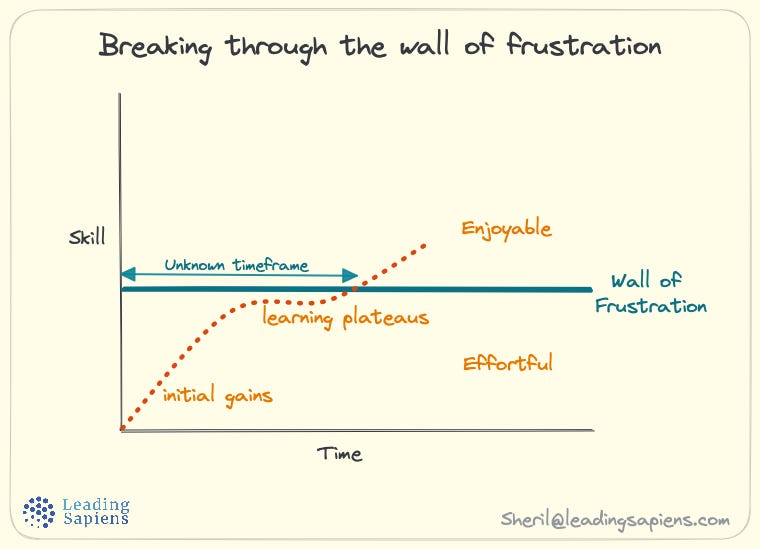In leadership and life, ambitions often outpace our ability to consistently execute on them. A hidden hurdle that trips up many is their level of “frustration tolerance.” This is particularly true in large organizations that are literally designed to frustrate ambitions and agendas.
In this piece, I unpack the critical yet under-explored construct of frustration tolerance, its effects on organizational life, and role in effective leadership.
Organizations are complex systems with numerous moving parts, conflicting interests, and unpredictable humans. We keep forgetting this to our detriment.
Consider a newly appointed exec with a mandate for change. Their initial optimism often collides with an unseen barrier, not external market forces or competition, but internal friction inherent to large organizations. This friction — stemming from conflicting interests, established processes, and human systems — becomes a litmus test of leadership efficacy.
From years of observing corporate ecosystems, I have realized that frustration tolerance is a key differentiator between those who create impact and those whose ambitions falter against the headwinds of organizational complexity.
Frustration tolerance is more than patience. It's almost a requirement for navigating the convoluted workings of corporate structures without losing sight of objectives.
What is low frustration tolerance?
When you first read the definition of low frustration tolerance, it’s easy to dismiss that we don’t in fact fall for it. CBC’s (Cognitive Behavioral Coaching) definition of frustration tolerance takes it to the extremes for valid reasons.
I contend it affects people at a much subtler level in the workplace, primarily due to day-to-day frictions of organizational life that accumulate over time. If not alert to it, it can take a real toll, leading to career derailment.
To begin with, what is frustration? William Knaus explains:
Psychologists …define frustration as a condition that exists when a goal “suffers interference.”
Frustration involves goal blockage or thwarting, followed by dissatisfaction. Few can avoid feeling frustrated over events such as walking to one’s motor vehicle and seeing an unexpected flat tire. Learning can involve frustration when we go over the same territory, and progress seems stalled.
Frustration is a natural, primary, affective response to a perceived barrier.
…This reaction to a barrier is often colored and shaped by the language we use to describe experience. Frustrations can erupt when we face a disparity between what we tell ourselves what we wanted, and what is...
Frustration resides on a continuum. The process involves sensations of discomfort that can range from barely perceptible to powerful. If sufficiently intense, frustration can disrupt memory functions and result in disorganized thinking and behaving.
Frustration tolerance is your capacity to navigate and endure challenging situations, setbacks, and organizational complexities without succumbing to negative emotions or counterproductive behaviors.
People with high frustration tolerance can endure discomfort to achieve their goals, viewing it as inevitable and manageable. On the other hand, those with low frustration tolerance see difficulties as unbearable and give up easily. They prioritize immediate comfort over long-term goals.
Explaining low frustration tolerance, Albert Ellis writes:
…a major reason that people perpetuate their psychological problems is that they adhere to a philosophy of low frustration tolerance (LFT). Such people believe that they must be comfortable and thus do not work to effect change because such work involves experiencing discomfort.
They are short-range hedonists in that they are motivated to avoid short-term discomfort, even though accepting and working against their temporary uncomfortable feelings would probably help them to reach their long-range goals. … They prefer to remain with their "comfortable discomfort" rather than face the change-related discomfort that they believe they must not experience. …
Another prevalent form of LFT is "anxiety about anxiety." Here, individuals believe that they must not be anxious and thus do not expose themselves to anxiety-provoking situations because they might become anxious if they did so—an experience they would rate as "awful." As such, they perpetuate their problems and overly restrict their lives to avoid experiencing anxiety.
Ellis’ conception of low frustration tolerance includes:
- Viewing difficulties and setbacks as catastrophic and unbearable.
- Giving up quickly on challenging tasks.
- Prioritizing short-term pleasure over long-term goals.
- Using maladaptive coping mechanisms like procrastination and avoidance.
He emphasizes that frustration is a natural part of life, but our beliefs about it determine our emotional responses. The key is avoiding what he calls cognitive distortions.
High frustration tolerance individuals understand that not getting what they want isn’t the end of the world, while those with low frustration tolerance catastrophize and demand that things should be different.
Frustration tolerance in leadership
In organizational leadership, frustration tolerance is crucial. Leaders with high frustration tolerance can navigate bureaucratic hurdles, interpersonal conflicts, and slow progress without losing sight of their objectives. In contrast, those with low frustration tolerance may:
- Abandon initiatives prematurely.
- React disproportionately to setbacks.
- Create a tense work environment due to their inability to manage their own frustrations effectively.
While we generally don't expect workplaces to be effortless, there's often a disconnect between our expectations and reality. Recognizing and accepting this discrepancy is key to developing frustration tolerance.
In the professional world, there's a tendency to expect:
- More order than chaos
- More rationality than irrationality
- More efficiency than inefficiency
However, the reality of organizational friction contradicts these expectations. Workplace frustration stems from various sources:
- Bureaucratic processes
- Conflicting priorities
- Limited resources
- Interpersonal conflicts
These are seen as impediments rather than inherent aspects of organizational life.
This misalignment leads to a "meta-frustration" – frustration about being frustrated – which creates a cycle of negativity where we become increasingly intolerant of "normal" workplace challenges.
As Lao Tzu noted,
He who thinks everything easy will end by finding everything difficult.
This kind of meta-frustration impacts your ability to navigate organizational complexities. If left unchecked, it leads to decreased productivity, job dissatisfaction, and burnout.
What causes low frustration tolerance?
Understanding the root causes of low frustration tolerance helps with identifying triggers and developing strategies to overcome it. The CBC approach identifies four main types of irrational beliefs (IB) that create low frustration tolerance.
IBs are rigid, absolute, and often unrealistic demands about how life or organizations "should" be, how others "must" behave, and how one "must" perform. When these demands are unmet, we experience excessive frustration, emotional distress, and engage in maladaptive behaviors.
1. Demands for comfort and ease
Discomfort intolerance revolves around the belief that life "should" be easy, comfortable, and free of hassles, effort, and inconvenience. In organizations, this manifests as:
- "This process shouldn't be so convoluted."
- "Why can't people just do their jobs without constant oversight?"
- "Meetings should be quick and efficient, not drawn-out discussions."
This demand for comfort leads to avoiding challenging tasks, procrastination, and difficulty persisting in the face of obstacles.
The illusion of effortless success can cause leaders to delegate difficult tasks or avoid confronting underperforming team members. High performers might focus solely on tasks they excel at, limiting their growth and skill development.
2. Demands for fairness and entitlement
This distorted sense of justice centers on the belief that we are entitled to certain outcomes and that others "must" treat us fairly. In the workplace, this might look like:
- "I deserve a promotion after all my hard work."
- "My ideas should be given more weight in meetings."
- "It's not fair that others get more recognition than me."
Entitlement leads to resentment, interpersonal conflicts, and a victim mentality.
Leaders might demand special treatment or resist feedback, while high-performers may feel owed certain rewards or engage in cutthroat competition, undermining teamwork.
3. Demands for achievement and perfectionism
Achievement frustration involves setting unrealistically high standards and demanding perfect or near-perfect performance. This might show up as:
- "My presentation must be flawless, or I'll be seen as incompetent."
- "If I don't meet this deadline perfectly, I'm a failure."
- "Any mistake in my work is unacceptable."
This demand for perfection leads to procrastination, excessive self-criticism, and difficulty completing tasks. Perfectionistic leaders might set impossibly high standards, leading to burnout and stifling innovation. High performers driven by perfectionism can become workaholics or struggle to delegate tasks.
4. Demands for emotional control and certainty
Emotional intolerance revolves around the belief that we "must not" experience negative emotions and that these are intolerable.
This might sound like:
- "I can't handle the uncertainty of this project's outcome."
- "Feeling anxious about this presentation is unacceptable."
- "I must always appear calm and in control at work."
The facade of stoicism that many leaders create can be particularly damaging by creating a culture where vulnerability is seen as weakness. High-performers might internalize stress and avoid seeking support, leading to burnout.
Reframing organizational friction
High frustration tolerance won’t eliminate workplace challenges, but it will equip you to approach them constructively.
It’s like learning to navigate a bustling city. At first, the traffic, noise, and crowds seem like overwhelming obstacles. But over time, you see these elements as essential aspects of urban life.
Organizational friction isn't just a roadblock to be overcome; it's the texture of the corporate landscape. Just as a seasoned city dweller learns to weave through busy streets and finds shortcuts, those with high frustration tolerance don't just endure organizational complexity; they learn to harness it.
Friction is what allows you to walk without slipping or to strike a match.
In organizations, that same friction — the push and pull of diverse opinions, the resistance of established processes, and the heat generated by competing priorities — creates the spark of innovation and the traction for change.
By reframing organizational friction as an essential feature of the corporate ecosystem, you develop the cognitive flexibility to thrive in complexity and keep playing the long game.
Further reading
In my newsletter I examined frustration tolerance in the realm of personal goals. My new resolution: be willing to tolerate more frustration.

Sources
- Knaus, W. J. Frustration Tolerance Training for Children.
- Ellis, A., & Dryden, W. (2007). The Practice of Rational Emotive Behavior Therapy.
- Harrington, N. (2005). Frustration Intolerance as a Multidimensional Concept. Journal of Rational-Emotive and Cognitive-Behavior Therapy.
- Ellis, A. (2005). The Myth of Self-esteem.
- Neenan, M. (2009). Developing Resilience: A Cognitive-Behavioural Approach.
- Grieger, R. (2007). The Use of REBT Principles and Practices in Leadership Training and Development. Journal of Rational-Emotive & Cognitive-Behavior Therapy.



